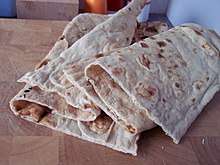Frybread
Frybread (also spelled fry bread) is a flat dough bread, fried or deep-fried in oil, shortening, or lard. Made with simple ingredients, frybread can be eaten alone or with various toppings such as honey, jam, powdered sugar, venison, or beef. Frybread can also be made into tacos, like Navajo tacos.
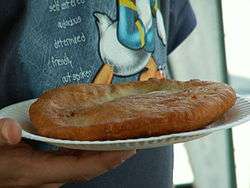 | |
| Type | Flatbread |
|---|---|
| Place of origin | United States |
| Main ingredients | Dough, leavening agent, fat (oil, shortening, or lard) |
| Other information | State bread of South Dakota |
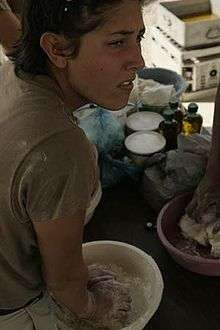
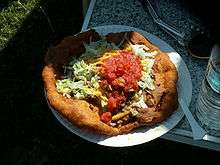
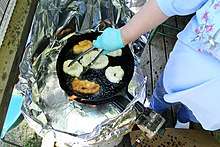
History
According to Navajo tradition, frybread was created in 1864 using the flour, sugar, salt and lard that was given to them by the United States government when the Navajo, who were living in Arizona, were forced to make the 300-mile journey known as the "Long Walk" and relocate to Bosque Redondo, New Mexico, onto land that could not easily support their traditional staples of vegetables and beans, New Mexican cuisine style sopapillas also share this origin due to Pueblos and Hispanos of New Mexico having a similar subsistence at this time.[1][2] Boarding schools also helped to spread frybread in Native American diets.[3]
For many Native Americans, "frybread links generation with generation and also connects the present to the painful narrative of Native American history".[1] It is often served both at home and at gatherings. The way it is served varies from region to region and different tribes have different recipes. It can be found in its many ways at state fairs and pow-wows, but what is served to the paying public may be different from what is served in private homes and in the context of tribal family relations.
Controversy
Frybread's significance to Native Americans has been described as complicated[4] and their relationship with it conflicted.[5] Although frybread is often associated with "traditional" Native American cuisine, some Native American chefs reject it as a symbol of colonialism. Indigenous chef Sean Sherman calls it "everything that isn't Native American food",[6] writing that it represents "perseverance and pain, ingenuity and resilience".[7] Frybread became a symbol of resilience as it was developed out of necessity using government-provided flour, sugar, and lard.[8] However, indigenous chefs such as Sherman consider it a symbol of colonial oppression,[8] as the ingredients were being provided because the government had moved the people onto land that could not support growing traditional staples like corn and beans.[4][9] The journalist and documentary filmmaker Patty Talahongva, who identifies as Hopi of the Corn Clan, calls frybread "Die Bread" and associates it with diseases endemic to Native Americans, including gallbladder disease, diabetes, and more. She attributes the spread of frybread to boarding schools, like the Phoenix Indian School, which she attended in the late 1970s. She also describes the movement towards indigenous food sovereignty – which promotes healthy foods like corn, beans, and squash, instead of starchy, high-fat foods like frybread – while citing the importance to this effort of Roxanne Swentzell (Santa Clara Pueblo); Winona LaDuke (Ojibwe); Nephi Craig (Apache and Navajo); Loretta Barrett Oden; Sean Sherman (Oglala Lakota); Brian Yazzie (Navajo); and the culinary ethnobotanist Tashia Hart.[3]
Nutrition facts
The U.S. Department of Agriculture reports that a plate of fry bread consists of 700 Calories and 27 grams of fat.[10]
Varieties
A typical frybread recipe consists of flour, water, salt, a small amount of oil, and baking powder. The ingredients are mixed and worked into a simple dough, and covered with a cloth for 30 minutes to an hour, until the dough rises. It is then formed into small balls, and are either rolled or pulled into flat discs prior to frying in hot oil. Many variations of this basic recipe exist, including substituting mayonnaise for oil in the dough (which produces a crisp, crunchy texture that resists getting soggy - ideal for Navajo tacos), and leavening the dough with a small container of yogurt or soured milk instead of using baking powder or yeast (produces a rich, sourdough flavor but requires several hours to fully leaven after the dough is prepared). Most frybread recipes do not use yeast at all because it was not typically available to Native peoples when this foodstuff was developed. In many Native American households, frybread dough is mixed early in the morning and left in a large bowl covered with a cloth to leaven and is used throughout the day to prepare fresh bread when needed.
Other facts
In the Americas
- Frybread was named the official "state bread" of South Dakota in 2005.[11]
- The traditional Utah and Southern Idaho "scone" is almost indistinguishable from frybread, due to the similar situation of limited resources faced by the Mormon pioneers of the 1800s.
In the Caribbean
- In Trinidad and Tobago it is called fry bake and eaten with fried shark, tomato choka, or saltfish buljol.
In Europe
- In Bulgaria (Eastern Europe), there is a similar food called mekitsa.
- In Hungary (Central Europe), there is a similar food called lángos.
- In Greece (Mediterranean), there is a similar food called tiganopsomo (tηγανόψωμο), which literally translates to "frybread," or "panbread".
- In Italy (Mediterranean), there are similar foods called gnocco fritto and pizza fritta, which exists in several regional variants. Some are very similar to the Native American recipe.
In Africa
- In Tunisia (Mediterranean) there are similar foods, sweet and salty, called bambalouni and fricasse. The former is a fried dough doughnut that can be eaten with honey or sugar, while the latter is a fried dough sandwich with eggs, tuna, olives and harissa paste.
- In South Africa it is called "vetkoek" and it is usually eaten with curried mince or syrup.
In Asia
See also
- Bannock
- Bhatoora
- Boortsog
- Deep-fried pizza
- Fried bread
- Fried dough
- Fried dough foods
- Lángos
- List of bread dishes
- List of quick breads
- Native American cuisine
- Puri (food)
- Sopaipilla
References
- Miller, Jen. "Frybread". Smithsonian.com. Retrieved January 20, 2012.
- Sokolov, R. (1993). Why We Eat What We Eat. Atria Books. p. 170. ISBN 978-0-671-79791-1. Retrieved November 22, 2019.
- Talahongva, Patty (Spring 2018). "No More 'Die Bread': How Boarding Schools Impacted Native Diet and the Resurgence of Indigenous Food Sovereignty". Journal of American Indian Education. 57:1: 145–53 – via JSTOR.
- Miller, Jen (2008). "Frybread". Smithsonian. Archived from the original on May 26, 2019. Retrieved June 4, 2019.
- Rupp, Rebecca (November 23, 2016). "Native American Cuisine Returns to Its Roots". National Geographic. Archived from the original on June 4, 2019. Retrieved June 4, 2019.
- Lam, Francis (November 3, 2017). "Exploring indigenous kitchens of North America with Sean Sherman". www.splendidtable.org. Archived from the original on June 4, 2019. Retrieved June 4, 2019.
- Sean Sherman; Beth Dooley (2017). The Sioux Chef's Indigenous Kitchen. University of Minnesota Press. ISBN 978-0-8166-9979-7.
- Judkis, Maura (November 22, 2017). "'This is not a trend': Native American chefs resist the 'Columbusing' of indigenous foods". Washington Post. Archived from the original on June 3, 2019. Retrieved June 3, 2019.
- d'Errico, Peter (July 13, 2017). "(Not) Fry Bread: The Sioux Chef's Indigenous Kitchen". IndianCountryToday.com. Archived from the original on June 4, 2019. Retrieved June 4, 2019.
- "USDA National Nutrient Database for Standard Reference, Release 23" (PDF). USDA. Archived from the original (PDF) on October 21, 2011.
- NetState.com. Official State Foods. 2006. February 18, 2007.
External links
| Wikibooks Cookbook has a recipe/module on |

- Encyclopedia of Oklahoma History and Culture - Fry Bread
- Recipes for frybread by Tribe or Nation
- Navajo Fry Bread History
- Fry Bread Facts
- More Than Frybread Mockumentary
- Fry Bread House Honored Among the Best of the Best — frybread restaurant in Phoenix a winner of 2012 "America's Classics" James Beard Foundation Award.
- Diet or Fry It, Gen Huit, Salish
